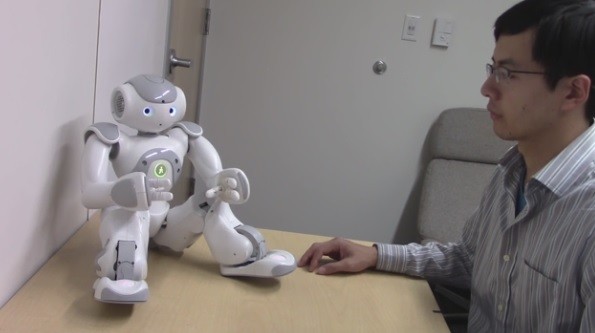By Ana Verayo, | April 06, 2016

The experiment consisted of instructions spoken by the robot followed by 26 trials. Each trial had three parts. 1. Robot asks participant to touch it. 2. Participant touches robot's body part. 3. Robot teaches participant medical term for the body part.
Researchers reveal how an "intimate touch" from a humanoid robot can induce a physiological response from a human.
This android robot is less that two feet high that also possesses eyes, ears and a torso, including arms and legs which can also strike up a conversation with humans. The robot then challenges volunteers to touch its body and point to its body.
Like Us on Facebook
In this new study, researchers discovered that when humans tried to touch a robot's buttocks or genitals, it also produced a measurable arousal response from the volunteers.
According to lead author of the study, mechanical engineer Jamy Li from Stanford University in California, this work reveals that robots are already fast becoming a new form of media that can be potentially powerful. It also shows that humans respond to robots in a social yet primitive manner. When it comes to touching the private parts of others, social conventions also apply to robotic body parts as well.
New findings also prove that humanoids can also produce a response from humans even from a simple touch. During the experiments, there were 10 human volunteers that are composed of four females and six males where the volunteers responded to the commands of a Aldebaran Robotics Nao robot, which has been programmed to ask the participants to touch any of its 13 parts of its body. The volunteers were also wearing a sensor that obtains measurements of skin conductance which indicates any physiological response that could involve emotional or arousal.
The results from the 26 trials reveal that when asked to touch the "less accessible" parts of the robot, it was apparently more arousing compared to touching the android's hand or feet. When asked to only point at these private parts, there was no response given by the volunteers.
Researchers concluded that social robots can give out human physiological responses resulting in a hidden power of robots, which should act as a caution for designers when it comes to the mechanical and interactive aspects of the robot, to also consider the positive and negative effects of human-robot interactions.
The robot did not possess any sort of artificial human skin as it is covered with a plastic similar to toys that also has no textural or temperature differences in any region of its body. This means that skin contact does not produce any arousals for the volunteers but rather, the response was higher in body parts that have low accessibility.
Scientists say that in the near future, robots that consist of human forms can assist in personal and public places which ask questions such as what kinds of relationships can humans foster with robots and what are the social conventions in body accessibility which are clearly applied to robots as well.
This new study will be discussed at the 66th International Communication Association in Japan this June.
-
Use of Coronavirus Pandemic Drones Raises Privacy Concerns: Drones Spread Fear, Local Officials Say

-
Coronavirus Hampers The Delivery Of Lockheed Martin F-35 Stealth Fighters For 2020

-
Instagram Speeds Up Plans to Add Account Memorialization Feature Due to COVID-19 Deaths

-
NASA: Perseverance Plans to Bring 'Mars Rock' to Earth in 2031

-
600 Dead And 3,000 In The Hospital as Iranians Believed Drinking High-Concentrations of Alcohol Can Cure The Coronavirus

-
600 Dead And 3,000 In The Hospital as Iranians Believed Drinking High-Concentrations of Alcohol Can Cure The Coronavirus

-
COVID-19: Doctors, Nurses Use Virtual Reality to Learn New Skills in Treating Coronavirus Patients







